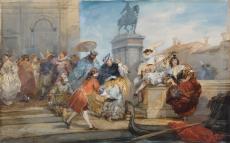


Having succeeded in maintaining the support of the successive regimes of Louis-Philippe, the July Monarchy and the Second Empire, Eugène Lami, an independent artist, a dandy and a friend of the writer Alfred de Musset, knew how to be the chronicler of his age and at the same time the elegant storyteller of eras gone by. Especially known for his watercolour and gouache paintings, Lami, who had been a student of the celebrated military painter Horace Vernet (1789-1863), first won acclaim for his depictions of military scenes and his documentary precision. He also often illustrated the daily life of high society and the royal court. The events of 1848 forced him into exile to London, where he was very well received. Following his return to France in 1852, he became one of the most respected artists of the Second Empire.
Lami also features in the history of the arts of the 19th century for having been chosen by Baron James de Rothschild as an interior design consultant for his castle at Ferrières, near Paris. A masterpiece created by English architect Joseph Paxton (1803-1865), this exceptional edifice was built between 1853 and 1861. A sumptuous residence, it was dedicated to a return to the taste of the 18th century and the triumph of the pastiche, and included a suite of staterooms and a smoking room decorated with Venetian scenes that tried to recreate the magic of the Venetian Rococo. This watercolour and gouache study is probably the model for one of the canvases used to decorate the smoking room. P.-A. Lemoisne, Lami’s biographer and author of his catalogue raisonné, cited a letter from the artist to his sponsor, Baron de Rothschild, which shows the studious approach of the artist, who had travelled to Venice: ‘For the past ten days, I have been drawing from morning till night, and very often I was thinking of you. The Baroness made arrangements for a permission to draw in the Palazzo Ducale and in the rooms where the public do not enter. I picked up some ideas that are quite new and picturesque.’ Technical mastery and first-hand knowledge of the large-scale Venetian decorative schemes, especially those by Giovanni Battista Tiepolo (1696-1770) and the masters of genre painting such as Pietro Longhi (c. 1702-1785), make this work a brilliant and attractive summary of Lami’s art. This watercolour offers the viewer a quintessential vision of a dream-like Venice, full of grace and exoticism, which continues to exist to this day through famous aristocratic parties, such as Carlos de Beistegui’s ‘Bal Oriental’ at the Palazzo Labia in 1951, or the revival of the Venetian carnival for the tourists of the 21st century.
Known for his watercolours, gouaches and lithographs, Lami studied under the military painter Horace Vernet. His early military scenes were acclaimed for their precision. Later, he became famous for his depictions chronicling fashionable society and the royal court, with an emphasis on costume. In 1832 he was appointed court painter to Louis-Philippe. From 1848 he was exiled in London, and upon his return to France in 1852 he was hailed as one of the most respected artists of the Second Empire.